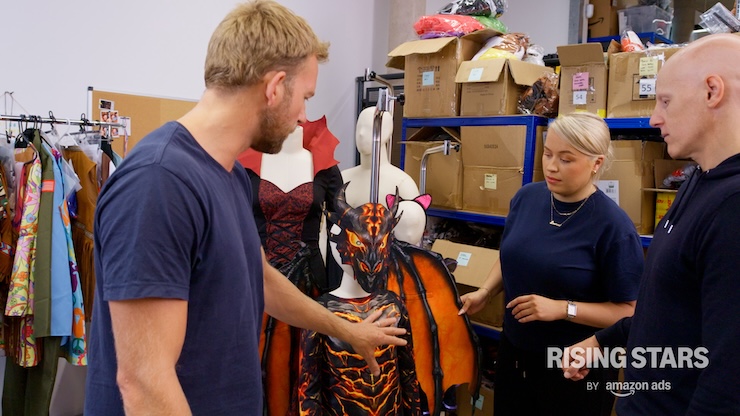At the last count it was revealed that Instagram has 600 million monthly active users with 400 million of those active on the platform every day – that’s 20 per cent of all internet users.
This being the case, you can understand why many businesses are focusing on the visual platform to generate leads, customer engagement and brand awareness.
Here are six key steps for businesses looking to generate results from Instagram.
1. Create a business account
If you’re considering amplifying your brand and business on Instagram the first step is to set up an account, but what do you do next?
As a business, it’s important that you use the settings function to switch over to a business account as this unlocks a variety of insights you don’t have access to as a personal user.
Once you’ve switched over to a business account it’s time to start following other accounts and posting images and videos.
With any luck you’ll have considered a content strategy before signing up to the platform but realistically, you can develop a strategy at any point and start implementing.
Related: How to get 1,000 followers on your small business Instagram
2. Curate your profile grid
At the core of your content strategy you should be considering what your overall grid will look like.
The grid is the thumbnails of your images on your profile page and this is your shop window on Instagram.
While your individual photos and videos will be what initially attracts another user to your account, it’s the grid on your profile that people will look at to get an idea of the variety of content you post and decide if they want to follow you.
The visual community on Instagram can be fickle and if you post content that your followers aren’t expecting or the quality isn’t as good as they’re used to, it can mean that they actively unfollow your account.
While your imagery needs to be consistent they don’t need to be identikit and this is important to remember. It’s more about placing images together that complement each other, just as you would in a brochure or on your website.
You should consider the colour palette, type of background, use of natural lighting and how much of an insight you are happy to give into your company. An example of a curated gallery is from Northern Monk Brewery, a craft brewery in Leeds who in their grid below have included flatlays of products, behind the scenes insight, people enjoying their beer and a snap of their venue, The Refectory.
While the variety of content might seem disjointed when described, the peach/orange undertones of each image help pull them together. It’s clear for a potential follower to understand that beer in some form will be included in their images but it may not always be the direct feature.
There are a few ways you can curate your grid before posting – you can have a private account to test content or you can download another app such as UNUM which allows you to create/update your grid with images you haven’t uploaded yet and move them around until you’re happy.
There are a number of other useful features within the app too such as posting directly to Instagram.
3. Be an active part of a community
Having the right images is just one piece of the puzzle on Instagram and it’s arguably the smallest. For many small businesses on the platform, true success comes from the community they are part of and support/are supported by.
One of the strongest small business communities on Instagram, aside from influencers, is entrepreneurial mums. Brands who were set up by women fulfilling a gap in the market for offering minimalist designs / harder to find Scandinavian brands have created a community where they support each other by featuring each other’s products in their images, commenting on each other’s feeds and collectively creating a desirable competition prize.
An example of a competition prize loop is shown below. The image is posted by Mama Designs and Keira, the founder, has tagged another business in the image.
The audience is expected to like the image, click on the tag and then follow the related account until they have completed the loop and then it is usually asked that they comment on the original account for their entry to count.
It sounds more complicated than it is to implement but offering a prize into a similar forthcoming loop is a good way to introduce yourself to likeminded businesses.
However, while competitions can be successful in terms of increasing your numbers, you have to remember that your long term content has to meet the needs and expectations of your new followers.
Similarly, it is important to stay up to date with relevant Instagram competition guidelines to ensure that you don’t fall foul of any newly implemented terms of use.
It goes without saying that a community doesn’t built itself so you need to dedicate at least 10 minutes a day to engage with other users by liking their posts, commenting and responding to their content on Instagram Stories.
Commenting doesn’t only just connect you with the user of the account you’re commenting on but it can raise your profile among their audience too, as shown by the example below:
In this image we can see that the supplier has commented on the photo of a dish that has been created from their produce. As a consumer who may or may not indulge in the dish, I’m inclined to click on their profile and learn more after being enticed by the photo of the meal.
4. Find and use relevant hashtags
Last summer the way in which content is displayed on Instagram changed. It had previously been in chronological order but an algorithm was introduced to show users content that Instagram thinks they will like and in order of preference rather than time.
Not too dissimilar from the algorithms used by Facebook and Twitter, the images that are shown are from accounts that users have recently engaged with in some way. The algorithm is also used to introduce similar images to users through the Explore page and these are chosen from the searches made by the user.
Following the introduction of the algorithm, one of the only ways of being seen by people that don’t follow you is by using hashtags. You can use up to 30 hashtags and these can be featured in your caption or a comment (most businesses use comments or use breaks so that they come a few lines below the caption).
As of today (30th March) it has been assumed that accounts using the same hashtags everyday are losing visibility on the platform as it highlights that their content isn’t relevant. For those who are new to hashtags or need some inspiration following today’s assumptions, there are a couple of websites you can use to discover new hashtags.
One of the best I’ve found is Focalmark are it allows you to select your niche and location. For example, the following hashtags were suggested for someone sharing interior design images from Bristol. These would be perfect for a small business in Bristol selling homewares.
#medecor #interior4all #decoration #interiores #furniture #homestyle #interiors #inredning #archilovers #interiorstyling #architecturelovers #interior123 #myhome #interiordecor #homedesign #finahem #livingroom #nordiskehjem #archidaily #arquitecturadeinteriores #igersbristol #livebristol #bristol247 #bestofbristol #visitbristol #bristol_lens
Other great resources are Me and Orla’s monthly hashtag email. Sara of Me and Orla puts together a list of her favourite hashtags for the forthcoming month and gives you an overview of the type of images that would fit within that hashtag theme.
5. Don’t be afraid of advertising
With 1 million active advertisers on Instagram it’s clearly a platform where brands are vying for attention but don’t let that put you off. It’s easy to set up paid promotions, particularly if you’re already au fait with the Facebook Advertising set up as it’s managed from there.
One of the best features of Instagram’s advertising functionality is that you can be very specific with your targeting (as you can on Facebook) so you can ensure that you’re getting your brand in front of the right people and delve into various sets of data about your target audience.
Following the release of the Stories function (a Snapchat-esque feature where you can take instant images/videos and they will disappear after 24 hours), there are increased advertising opportunities that you can test with smaller budgets before committing long term budget.
6. Be creative
While there are a variety of strategic considerations you need to remember to inform your strategy, what any form of visual advertising comes down to is creativity.
There are multiple ways you can be creative on Instagram; from giving a peak behind the scenes through Instagram Stories (try not to upload too many times though as people will just skip through if it seems overwhelming), creating a whole image from 9 individual photos to drive users to your profile, using the slideshow feature to create a flipbook style animation to gradually showing close up images of products in a wider image.
The example below is of Boden’s use of a video to show a number of items passing hands. What the British clothing company are selling is not always the items passing hands and this is a good, soft sales approach to highlighting their range of Breton tops.
Users won’t bemoan a bit of creativity but they won’t forgive a boring grid of images so challenge yourself within the constraints of the guidance above and see your account grow.
This article was written by Kay Brown on behalf of Blueclaw.





